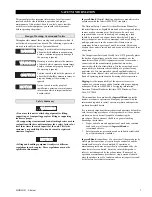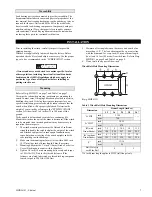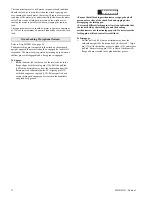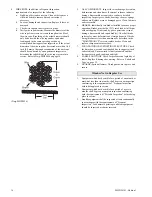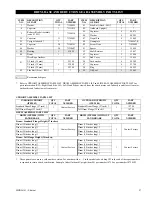
16
MHD56181 - Edition 1
4.
WIRE ROPE. In addition to Frequent Inspection
requirements, also inspect for the following:
a.
Build-up of dirt and corrosion. Clean with steam or a
stiff wire brush to remove dirt and corrosion if
necessary.
b.
Loose or damaged end connection. Replace if loose or
damaged.
c.
Check wire rope anchor is secure in drum.
d.
Verify wire rope diameter. Measure the diameter of the
wire rope from crown-to-crown throughout the life of
the wire rope. Recording of the actual diameter should
only be done with the wire rope under equivalent
loading and in the same operating section as
accomplished during previous inspections. If the actual
diameter of the wire rope has decreased more than 1/64
inch (0.4 mm) a thorough examination of the wire rope
should be conducted by an experienced inspector to
determine the suitability of the wire rope to remain in
service. Refer to Dwg. MHP0056 on page 16.
(Dwg. MHP0056)
5.
ALL COMPONENTS. Inspect for wear, damage, distortion,
deformation and cleanliness. If external evidence indicates
damage, disassemble as required to conduct a detailed
inspection. Inspect gears, shafts, bearings, sheaves, springs
and covers. Replace worn or damaged parts. Clean, lubricate
and reassemble.
6.
BRAKES. Individually test brakes installed to ensure proper
operation. Brakes must hold a 125% rated load at full drum
without slipping. If indicated by poor operation or visual
damage, disassemble and repair brake(s). Check all brake
surfaces for wear, deformation or foreign deposits. If brake
lining thickness is less than minimum, as described in the
“MAINTENANCE” section, replace brakes. Clean and
replace components as necessary.
7.
FOUNDATION OR SUPPORTING STRUCTURE. Check
for distortion, wear and continued ability to support winch
and rated load. Ensure winch is firmly mounted and that
fasteners are in good condition and tight.
8.
LABELS AND TAGS. Check for presence and legibility of
labels. Replace if damaged or missing. Refer to ‘Labels and
Tags’ on page 32.
9.
GUARDS (optional feature). Check guards are in place and
secure.
Winches Not in Regular Use
1.
Equipment which has been idle for a period of one month or
more, but less than six months, shall be given an inspection
conforming to the requirements of “Frequent Inspection”
before being placed in service.
2.
Equipment which has been idle for a period of over six
months shall be given a complete inspection conforming
with the requirements of “Periodic Inspection” before being
place in service.
3.
Standby equipment shall be inspected at least semiannually
in accordance with the requirements of “Frequent
Inspection”. In abnormal operating conditions equipment
should be inspected at shorter intervals.


